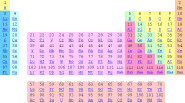


Oxygen
Oxygen exists as two allotropes. One allotrope is the well known colorless oxygen gas, which makes up approximately 20% of the Earth's atmosphere. Another allotrope is the blue ozone gas, consisting of 3 oxygen atoms. Normal oxygen is odorless and non-toxic. It, however, should not be breathed in high concentrations for a prolonged time. Pure oxygen in large amounts can be quite dangerous. Once, a fire is started in an environment with high oxygen concentration, it is almost impossible to stop it. Compounds, which burn at a normal rate in air can burn with an intense hot and violent flame in pure oxygen. Ozone is a toxic and corrosive gas, which is very unstable. It usually is not used at high concentration, but at low concentration in air or plain oxygen.
Pure oxygen can easily be made by the home chemist from hydrogen peroxide and a catalyst (e.g. manganese dioxide, potassium iodide, alkaline copper compounds). Oxygen can be used in nice experiments, e.g. as a constituent in detonating gas, see also section on hydrogen. Pure oxygen gas supports violent combustion and in such experiments, it should be used with care.
Ozone can hardly be produced at the home lab in reasonable quantities. It can be prepared with electric silent discharge equipment, but this is not suitable for the average home chemist.
![]()
Oxygen is present in many compounds, but there are only a few classes of compounds which have oxygen, available for oxidation purposes. Most notably are the compounds containing the peroxo-group O22- with oxygen in the –1 oxidation state. Another common group of compounds are the ones, containing a superoxo-group O2– with oxygen (at least formally) in the –½ oxidation state. For the general public, only compounds, containing a peroxo-group, are available:
- hydrogen peroxide, H2O2
- sodium perborate , NaBO3·4H2O
- sodium percarbonate, Na2[CO2(O2)]·H2O·½H2O2
- persulfates, Na2S2O8, K2S2O8, (NH4)2S2O8
- metal peroxides, Na2O2, BaO2, ZnO2
![]() Hydrogen peroxide is a very common compound, which is available for disinfection
purposes at drugstores at concentrations of 3% or 6% by weight. Sometimes it can
be purchased at 10% concentration for hair-bleaching purposes. Some drugstores
and chemical supply houses may sell the compound at a concentration of 30% -
35%.
Hydrogen peroxide is a very common compound, which is available for disinfection
purposes at drugstores at concentrations of 3% or 6% by weight. Sometimes it can
be purchased at 10% concentration for hair-bleaching purposes. Some drugstores
and chemical supply houses may sell the compound at a concentration of 30% -
35%.
![]() Concentrated
hydrogen peroxide is fairly dangerous and certainly cannot be shipped easily, so
it should be obtained locally. Hydrogen peroxide is thermodynamically unstable
and slowly decomposes. The speed of decomposition, however, can be greatly
reduced if it is stored in a cold dark place. Skin, exposed to hydrogen peroxide
at a concentration larger than 5%, becomes white. A the place of these white
spots the skin is highly irritated (a kind of burning and stinging sensation).
These spots disappear after several minutes. When the white spots have
disappeared, then the irritation also is gone. At a concentration of 30% this
effect is almost immediate.
Concentrated
hydrogen peroxide is fairly dangerous and certainly cannot be shipped easily, so
it should be obtained locally. Hydrogen peroxide is thermodynamically unstable
and slowly decomposes. The speed of decomposition, however, can be greatly
reduced if it is stored in a cold dark place. Skin, exposed to hydrogen peroxide
at a concentration larger than 5%, becomes white. A the place of these white
spots the skin is highly irritated (a kind of burning and stinging sensation).
These spots disappear after several minutes. When the white spots have
disappeared, then the irritation also is gone. At a concentration of 30% this
effect is almost immediate.
Hydrogen peroxide is a colorless liquid, which is miscible with water in any proportion. It is a remarkable compound, which can act both as a (strong) oxidizer (capable e.g. of liberating chlorine from hydrochloric acid), while on the other hand, it also can act as reductor. Besides that, hydrogen peroxide forms many interesting peroxo-complexes with a whole bunch of compounds in high oxidation states. The colors and chemical properties of these peroxo-complexes are remarkable. From an experimenter's point of view, hydrogen peroxide is a really interesting chemical, which should not be missing in a home lab. For most of the experiments, the standard 3% or 6% solutions are suitable. It is also fairly easy to make more concentrated hydrogen peroxide from a 3% solution, by freezing out part of the liquid in a fridge and keeping the part which remains liquid. Obtaining 10% solutions is easy this way, getting all the way up to 30% is possible, but is not recommended.
![]() Sodium perborate also can be purchased at many drugstores, and it is also
available at photography raw chemical suppliers. It is a convenient source of
hydrogen peroxide, when it is dissolved in water. Unlike hydrogen peroxide, it
is stable on storage, provided it is kept in a dry place. The actual structure
of the perborate ion is much more complex than the formula suggests. According
to Greenwood and Earnshaw, Chemistry of the Elements, a better formula for this
compound is Na2B2(O2)2(OH)4·6H2O.
It is a white powder or white crystalline solid. Many experiments, which require
dilute hydrogen peroxide, can also be conducted with this chemical, dissolved in
water or dilute acid.
Sodium perborate also can be purchased at many drugstores, and it is also
available at photography raw chemical suppliers. It is a convenient source of
hydrogen peroxide, when it is dissolved in water. Unlike hydrogen peroxide, it
is stable on storage, provided it is kept in a dry place. The actual structure
of the perborate ion is much more complex than the formula suggests. According
to Greenwood and Earnshaw, Chemistry of the Elements, a better formula for this
compound is Na2B2(O2)2(OH)4·6H2O.
It is a white powder or white crystalline solid. Many experiments, which require
dilute hydrogen peroxide, can also be conducted with this chemical, dissolved in
water or dilute acid.
![]() Sodium percarbonate also is a white powder, which is available as "Vanish
oxygen" washing powder in many drugstores. When it is dissolved in water, then
the liquid slowly evolves oxygen. This compound is suitable as a concentrated
source of hydrogen peroxide in alkaline solutions. In certain experiments it can
be used instead of hydrogen peroxide, but in acidic environments, the use of
sodium percarbonate may be less suitable. The percarbonate ion is not stable in
acidic environments. It decomposes, giving carbon dioxide gas and leaving
hydrogen peroxide in solution. The production of the carbon dioxide may
interfere with the experiment.
Sodium percarbonate also is a white powder, which is available as "Vanish
oxygen" washing powder in many drugstores. When it is dissolved in water, then
the liquid slowly evolves oxygen. This compound is suitable as a concentrated
source of hydrogen peroxide in alkaline solutions. In certain experiments it can
be used instead of hydrogen peroxide, but in acidic environments, the use of
sodium percarbonate may be less suitable. The percarbonate ion is not stable in
acidic environments. It decomposes, giving carbon dioxide gas and leaving
hydrogen peroxide in solution. The production of the carbon dioxide may
interfere with the experiment.
![]() Potassium persulfate is a white powder, which is available at electronics shops as
PCB-etchant, in European countries sometimes sold as "Seno Feinätz kristalle".
Sodium persulfate also can be obtained in many electronics shops as PCB etchant,
simply sold under its chemical name. If such shops do not have potassium
persulfate or sodium persulfate, then they will have ammonium persulfate,
which has very similar properties. From photography raw chemical suppliers
either sodium persulfate or potassium persulfate is available. The persulfate
ion differs from the perborate and percarbonate, in that it does not produce
free hydrogen peroxide, when dissolved in water. The persulfate ion probably is
the strongest oxidizer, available for the home chemist. It is capable of
oxidizing silver ions to a higher oxidation state than +1 and it also oxidizes
nickel to the +4 oxidation state! It is a very strong oxidizer, but also quite
sluggish, so reactions with persulfate usually are slow. The different nature of
persulfate, compared to the other peroxo-compounds, mentioned above, can nicely
be demonstrated with several transition metal compounds. The other peroxo
compounds all give rise to formation of peroxo-complexes with the metal, the
persulfate ions do not form such compounds.
Potassium persulfate is a white powder, which is available at electronics shops as
PCB-etchant, in European countries sometimes sold as "Seno Feinätz kristalle".
Sodium persulfate also can be obtained in many electronics shops as PCB etchant,
simply sold under its chemical name. If such shops do not have potassium
persulfate or sodium persulfate, then they will have ammonium persulfate,
which has very similar properties. From photography raw chemical suppliers
either sodium persulfate or potassium persulfate is available. The persulfate
ion differs from the perborate and percarbonate, in that it does not produce
free hydrogen peroxide, when dissolved in water. The persulfate ion probably is
the strongest oxidizer, available for the home chemist. It is capable of
oxidizing silver ions to a higher oxidation state than +1 and it also oxidizes
nickel to the +4 oxidation state! It is a very strong oxidizer, but also quite
sluggish, so reactions with persulfate usually are slow. The different nature of
persulfate, compared to the other peroxo-compounds, mentioned above, can nicely
be demonstrated with several transition metal compounds. The other peroxo
compounds all give rise to formation of peroxo-complexes with the metal, the
persulfate ions do not form such compounds.
Persulfate, or better called peroxo-disulfate, is a cheap and interesting compound for the home lab. When stored dry it keeps well for a very long time, especially the sodium and potassium salt. When it becomes moist it slowly decomposes, giving bisulfate and oxygen. The ammonium salt most easily decomposes.
![]()
![]()
![]() Sodium peroxide is
a yellow compound, which is very dangerous. It is available to the general
public and sometimes is used in certain pyrotechnic demonstrations, but its use
is strongly advised against. It does not add much to a home lab. As soon as it
comes in contact with water, hydrogen peroxide and sodium hydroxide are formed.
For dry-chemistry experiments it simply is too dangerous. Mixtures of sodium
peroxide with finely powdered reductors can ignite spontaneously.
Sodium peroxide is
a yellow compound, which is very dangerous. It is available to the general
public and sometimes is used in certain pyrotechnic demonstrations, but its use
is strongly advised against. It does not add much to a home lab. As soon as it
comes in contact with water, hydrogen peroxide and sodium hydroxide are formed.
For dry-chemistry experiments it simply is too dangerous. Mixtures of sodium
peroxide with finely powdered reductors can ignite spontaneously.
![]() Somewhat safer peroxides are barium peroxide and zinc peroxide. Both of these
react with water, giving a solution/suspension of the metal hydroxide, and
hydrogen peroxide in solution. These two peroxides also can be used in
pyrotechnic compositions and as such indeed they are used. Barium peroxide and
zinc peroxide are more stable than sodium peroxide. These peroxides are white
(or off-white) powders.
Somewhat safer peroxides are barium peroxide and zinc peroxide. Both of these
react with water, giving a solution/suspension of the metal hydroxide, and
hydrogen peroxide in solution. These two peroxides also can be used in
pyrotechnic compositions and as such indeed they are used. Barium peroxide and
zinc peroxide are more stable than sodium peroxide. These peroxides are white
(or off-white) powders.